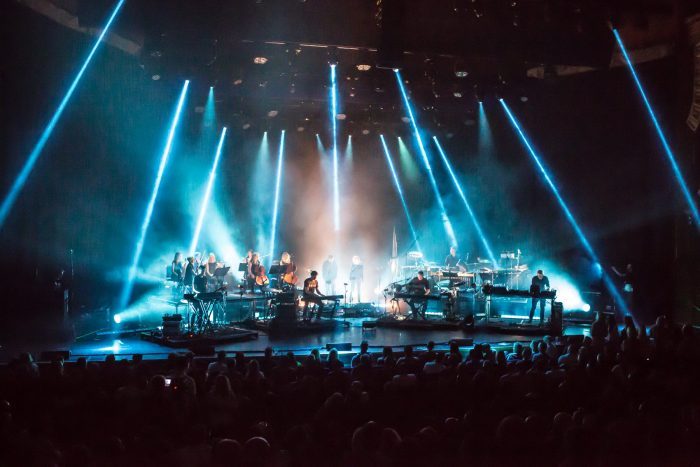 Features
Features
Strings 'n' synths: Like it or not, dance music's gone orchestral
Less raves, more concert halls
We're surveying 2017 across a series of features. Here we take a look at how 2017 was dominated by dance music orchestras
Backstage at the Barbican we find a collection of violinists, cellists, drummers, bassists, trombonists and other musicians getting ready to perform tracks by Sasha, but this isn’t your typical green room and this isn’t a quintessential rave.
Outside, hundreds of fans queue down the block in anticipation for this special performance, but judging by their image, this veteran rave crowd has gone through somewhat of a transformation. The revellers have ditched their dark, loose fitting t-shirts and tight jeans to don more formal attire, as they won’t be gyrating as hard on the dancefloor this night and certainly won’t be coming home when the sun rises. Nonetheless, they are expecting to hear their favourite Sasha tracks - a batch of trance classics, to be specific. Yet still, they’ll be exposed to something they’ve never heard before; there won’t be a DJ booth and the material will be performed entirely by an orchestra.
2017 saw a multitude of dance music artists dip their toes into the realm of performing with an orchestra. While it’s not exactly a new concept, this year, there was consistent buzz surrounding these unique showcases or releases. Sasha’s re-Fracted event at the Barbican in May was one of the more acclaimed instances, which explored music off his ‘Late Night Tales’ release as well as influential anthems from his back catalogue like ‘Xpander’. In a similar sense, Pete Tong’s Ibiza Classics event in Los Angeles and Sydney, which saw him perform iconic tracks like Daft Punk’s ‘One More Time’ with a 65-piece orchestra, revealed just how grand the performance can be.

Fusing recognisable classics with the orchestral medium was a major draw for punters looking to hear their favourite tracks reimagined in a creative way, like at the Haçienda Classiçal showcase at Glastonbury and throughout the UK. Take a look at Miss Moneypenny's as well. The iconic crew celebrated their 25th birthday with the Birmingham Gay Symphony Orchestra at the Symphony Hall. They performed everyone's favourite house classics to a sold crowd and it's a marvel to witness these performances, To expand on the concept though, a select few artists decided to take on the task of producing completely original material through the classical lense.
With arguably the most successful venture into producing orchestral arrangements, Jeff Mills continued to showcase his innovative artistic ability. He’s been experimenting with the classical motif for over a decade, exploring themes focusing on the expansive universe to create masterful soundscapes. In a way, he helped pioneer the concept of electronic savants taking on the task of writing music for a grand symphony. This year he carried the torch once again with more inspiring material.
In 2017, Mills delivered a string of live performances and releases focusing on symphonies, including gigs at the Barbican and soundtracking the iconic film Metropolis live at Kolonnadenhof der Museumsinsel, Berlin. While his Metropolis soundtrack was originally produced in 2000, this year, Mills attached his music to film in yet another successful instance. This time he produced the soundtrack to the influential motion picture A Trip To The Moon, which is now a highly sought after album and DVD.

Where others thought to take what was already there, like Tong and Sasha did with their performances, which at times seemed a bit convoluted, Mills naturally thought to express his own unique approach to writing music. In a similar sense, fellow Detroit-techno wizard Carl Craig created what was called “a symphony of techno”, producing and performing orchestral ballads he titled ‘Versus’. The collaboration with Francesco Tristano and the Paris-based Les Siècles Orchestra at times veered toward the club realm, with tracks like ‘The Melody’, which uses a 4/4 kick, easily possessing the ability to work magic on the dancefloor and also captivate a packed concert hall. In this sense Craig clearly stands out on his own, one foot in the club and the other in an opera house. Musical brilliance melding the classical and contemporary themes in ways not done before.
And lets not forget Marc Romboy, who instead of reimagining dance classics, flipped the perspective and offered his own take on the classical music of Claude Debussy, arguably the most influential composer of the 20th Century. ‘Reconstructing Debussy’, a collaboration with the Dortmund Philharmonic Orchestra, was described as “an overwhelming, orchestral adventure through time and techno”. Mixmag even premiered a track off the album earlier this year. Here Romboy stands out as taking on the orchestral medium with a unique and inventive concept.
While Mills and Craig’s originality stood out as imaginative artistic presentations and the orchestral performances provoked an influx of chatter throughout the industry, the renditions by Tong and Sasha were perhaps too grand for the source material. Dance music, house and techno in particular, is inherently based on rhythms, grooves and melodies to hypnotize and energise a dancefloor. Hearing ‘One More Time’ being performed by a 65-piece orchestra, although incredibly awe-inspiring, might be taking away from the core beauty of the original. That said, Mixmag would certainly like to see more classical symphonic experimentation as it’s exciting to present dance music culture in a new light. Hats off to all the producers and musicians who delivered inventive breakthroughs and made 2017 the year dance music went orchestral.
Harrison Williams is Mixmag's East Coast Editor, follow him on Twitter



